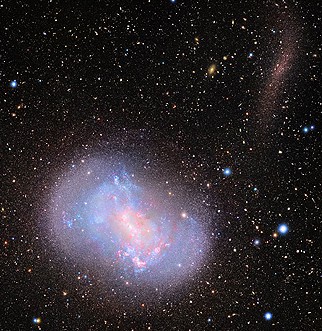Galaxy Games
Astronomers at the University of California, Santa Cruz are part of an international team that captured exciting first photos of a dwarf galaxy absorbing an even smaller galaxy.

While astronomers like Romanowsky have witnessed this process of galaxy absorption in larger galaxies, Romanowsky and a team of colleagues led by David Martinez-Delgado, Max Planck Institute for Astronomy, Germany, released photos last month that, for the first time, show the process being carried out on a smaller scale. NGC 4449, a dwarf galaxy located 12.5 million light-years from Earth is in the process of eating a smaller dwarf galaxy, and Romanowsky and team have photos to prove it!
A Closer Look
Photos initially taken by R. Jay GaBany showed evidence of a star stream along the outer edges of NGC 4449. This dense band of stars, the "remains" of the smaller galaxy, tipped the team of astronomers off to the fact that they had caught a dwarf galaxy red-handed, in the process of absorbing a smaller one.
Romanowsky and team took follow-up, in-depth long-exposure photos using the Japanese "Subaru" Telescope in Hawaii with the "Suprime-Cam" camera. "This is the most powerful astronomical imager in the world, like a digital camera on steroids," says Romanowsky. The Suprime-Cam lived up to its reputation, and the team laid claim to in-depth photos in which you can see individual stars in the stream. Whereas a typical "night"-mode photo on a point-and-shoot camera might involve an exposure of seconds, astrophotography often involves long exposures of hours. Surprisingly, given the 12.5 million light years in distance, the exposure was relatively short. "In the case of the dwarf-stream, the exposure lasted 8 minutes, which is a 'snapshot' by our standards," says Romanowsky.
The stunning photos created quite a stir among astronomers as they prove, clearly, that the pecking-order dynamic observed between larger galaxies also happens with smaller galaxies. "We have seen large galaxies like our own Milky Way absorbing smaller galaxies, but have not previously seen a small (or 'dwarf') galaxy absorbing a much smaller one," says Romanowsky. "This is important because it is not clear how dwarf galaxies grow, change, and form stars, and we now have evidence that mini-mergers can play a major role."
An Absolute Size-Based Phenomenon?
When asked if there might ever be an exception, if a smaller galaxy "could" take on the lead role and shred a larger galaxy, Romanowsky laughs. "No, that would be like an ant eating an anteater." While the comparison puts galactic things in perspective, Romanowsky admits that "the astronomical world does often defy intuition." Because galaxies are surrounded by "large envelopes of 'dark matter,'" it is possible to envision a scenario in which a smaller galaxy has the upper hand, says Romanowsky.
A galaxy's total mass includes both its visible matter and its dark matter, but the quantity of dark matter surrounding a certain amount of stars is not always the same. A bright galaxy that appears larger based on its visible mass could, in theory, have less total mass than a faint galaxy, suggests Romanowsky, which would bring its gravitational pull to bear on the larger galaxy, instead of the other way around. "It could, in principle, happen that a 'smaller' galaxy appears to be eating a bigger one," says Romanowsky. "That would be really interesting to see because it would help confirm some uncertain ideas about dark matter."
So it is "possible," but maybe not likely that a little galaxy could hold its own—or even win—against a visibly larger galaxy. In general, galaxies get larger by absorbing smaller galaxies, a reality the team's photos last month reinforced.
Cosmic Crumbs?
Romanowsky and team were lucky to catch the merger in progress, before the stellar stream was even further assimilated. But whether a team of astronomers sees a galactic gulp in progress or not, the growth of one galaxy and the extinction of another still happens, which raises a question—can you tell by looking at a galaxy that it has eaten other galaxies? Apparently, you can. Despite the fact that the shredded galaxy gets "absorbed," like the rings on a tree stump that indicate age, there are galactic markers that give astronomers an indication of a galaxy's pattern of growth—and previous meals.
According to Romanowsky, the stars in a galaxy have "distinct fingerprints that can be recognized even after two galaxies appear completely mingled." Identifying and tracking these trace fingerprints within a larger galaxy allows astronomers to chart the history of a galaxy. "This type of galactic forensics work is a major enterprise for studies of our own Milky Way," says Romanowsky, but such investigations are "a lot more difficult in distant galaxies."
Making Connections
Students interested in learning more about astronomy and galaxies, our own and others, may enjoy exploring the following Projects Ideas and related blog posts:
- Finding the Center of the Milky Way Galaxy Using Globular Star Clusters
- The Milky Way and Beyond: Globular Clusters
- The Golden State Star Party
- The Golden State Star Party - II
- The Golden State Star Party - III
Science Buddies Project Ideas in astronomy are sponsored by generous funding from the Northrop Grumman Foundation.
Categories:
You Might Also Enjoy These Related Posts:
- Plastics and Earth Day - Science Projects
- Arduino Science Projects and Physical Computing
- 10+ Robotics Projects with the BlueBot Kit
- 5 STEM Activities with Marshmallow Peeps
- March Madness Basketball Science Projects: Sports Science Experiments
- Women in STEM! More than 60 Scientists and Engineers for Women's History Month
- Explore Artificial Intelligence and Machine Learning with Student AI Projects
- 10 Reasons to Do the Rubber Band Car Engineering Challenge









